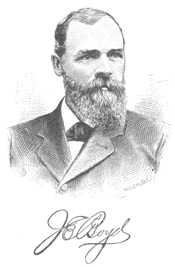Naper is an "inland town" (having no railroad) three miles from the South Dakota border in western Boyd County. It was started in 1899 on 80 acres, Ralph Naper and George Hotaling each relinquished 40 acres of their land. It has never increased in size. The town, first called "Naperville," was named for Ralph Naper. As a tribute to Hotaling's contribution, his son Abner and wife Oretha were crowned king and queen at the bicentennial celebration held in 1976.
The famous White Horse Ranch and Riding School (founded by Cal and Ruth Thompson) was located south of Naper. Many homes in Naper have miniature statues of white horses in their yards to show their pride in the White Horse Ranch. To commemorate the 50th anniversary of its founding, Ruth Thompson erected a building on Naper's Main Street in 1986. The world-wide horse registry of the International American Albino Association is kept in this building, as well as many mementos of the White Horse Ranch.
Dr. Charles Zimmerman, a frontier physician, also operated a pharmacy with the assistance of his wife Molly. In addition to serving the Naper community for 27 years, he was employed by the government as a doctor for the nearby Indian reservation. After his death in 1931, his wife donated his collection of over 300 items of Indian memorabilia to the Nebraska State Historical Society in Lincoln. Articles from this collection are on display in various state museums.
A recent brochure titled, "Naper is NOT Just Another Little Town" includes a list of organizations that have helped the town progress and enabled its citizens to have many enjoyable and educational activities. They include extension clubs, Band Boosters, Lions Club, VFW and auxiliary, and White Horse Boosters. The town also has a volunteer fire department which operates an EMT rescue unit.
Naper's slow-pitch softball team, which fields strong teams, won the Gregory County League Tournament (in South Dakota) in 1987. The next year, a chain-link fence was built around the ball diamond with money donated locally and matched by funds from Aid Association of Lutherans. A cable TV tower has also recently been completed.
A new schoolhouse was built in 1956 when 10 rural districts consolidated with Naper. The town has maintained a K-12 school since 1928. However, due to declining enrollment, the district merged with Spencer in 1988, with the first six grades remaining in Naper.
There are three churches in Naper which have services every Sunday. They are Catholic, Lutheran (Wisconsin Synod), and United Church of Christ (Congregational).
The only two-story building on Main Street was built in 1911 of cement blocks. It housed a bank until the 1930s, then was the post office. In 1988 a new frame post office was built on the corner where Blakkolb's store was located for many years, and the old building was razed.
The population of Naper peaked at 300 in 1910. By then, towns without a railroad were at a real disadvantage, losing businesses and residents to those that could provide rail connections. The town's population has remained at between 150-200 for the last 70 years, with the current count 155.
The oldest continuous business is Krotter's Lumber Yard. About 15 businesses and shops presently provide local services to the community.
Naper is a town whose residents stick together and cooperate on many projects. An example of this is the $27,000 raised in 1984 from local citizens and Naper High School alumni to apply towards the construction of a new auditorium to replace one destroyed by fire in 1983.
By Luree Barnes, Box 233, Naper, NE 68755
ADDITIONAL MATERIAL: History of Boyd County, 1938 , by Luree Snider Barnes*; Naper 1976 , by Loren Sieh*; History of Boyd County 75th Anniversary. *These books are available locally.


